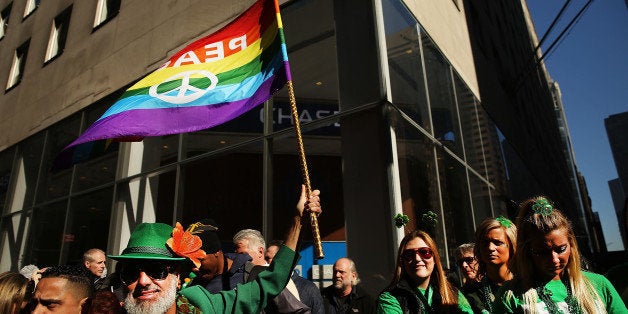
Twenty-three years ago, I was one of 25 gay, lesbian and bisexual Irish Americans who marched in Boston's St. Patrick's Day Parade under police escort. While some parade-goers opposed our presence by wearing t-shirts that read "90 years without the queers: Keep St. Patrick's Day straight," others welcomed us to their neighborhood. The most offensive signs ("God hates fags") were held by members of the Westboro Bapist Church, the Topeka, Kansas-based family cult that never misses an opportunity to promote anti-gay hatred. But I will never forget the woman who told me and the other members of the Irish American Gay, Lesbian and Bisexual Committee of Boston (GLIB), from the sidelines, "Don't listen to them. You're welcome here."
This Thursday, March 17, 2016 I will march with hundreds of LGBT Irish immigrants and Irish Americans up Fifth Avenue in the New York City St. Patrick's Day Parade. Our group, "Lavender and Green," is led by Brendan Fay, a gay immigrant from Drogheda who lost his job as a Catholic school teacher after he emerged as a spokesperson for gays and lesbians seeking to march in the New York St. Patrick's Day Parade. For the first time this year, the New York parade will allow a gay Irish group to officially participate.
Both the Boston parade committee and the New York committee succeeded for many years in excluding Irish gays from marching under their own banner. In Boston and New York many elected officials, first and foremost the late Boston Mayor Thomas Menino, boycotted exclusionary parades rather than condone anti-gay discrimination by their participation. This was a brave and principled stand. Brendan Fay organized an alternative "St. Pat's for All" parade in Sunnyside and Woodside, Queens, which attracts a racially diverse array of community groups, bands and dance groups. St. Pat's for All truly embodies the maxim that "everyone is Irish on St. Patrick's Day."
Growing up in suburban Boston, our Irish heritage was not contested. Our grandfather and cousins who came to Boston to work had heavy County Cork accents. We grew up listening to the Clancy Brothers and the Irish Rovers. We learned about the role our grandfather and great aunts played in the struggle for Irish independence. But when GLIB sought to march in the 1992 Boston parade -- technically the Evacuation Day Parade, celebrating the withdrawal of British forces from Boston March 17, 1776 after Americans moved heavy cannon to the top of Dorchester Heights in South Boston -- suddenly our Irishness was contested, in the pages Boston Globe and Herald, and on talk radio. The legitimacy of our participation in the Irish American community, as openly gay people, was challenged.
This was the era before combination anti-retroviral therapy. One of GLIB's members was a young gay man very sick with AIDS, in a wheelchair. Participation in the Boston Evacuation Day/St. Patrick's Day Parade, even under court order, was important to us, because our rejection by the parade organizers was a metaphor for the rejection many of us experienced within our families, in the workplace and in the broader society.
The parade controversy stimulated my interested in Irish history and culture. My Puerto Rican American partner at the time asked me, "You're that green thing, right?" I wondered, what is this heritage, this culture that people so hotly contest and seek to control? This led me to get involved supporting the work of human rights activists and those promoting the peace process in the north of Ireland. In 1994 I helped organize a multiracial group of U.S. activists in Boston called Peace Watch Ireland. In 1996 we started observing contested loyal order marches of the Orange Order and loyalist paramilitary bands through Irish Catholic neighborhoods in Northern Ireland as human rights observers. Our goal was to deter violence at the hands of hundreds of Royal Ulster Constabulary (RUC) officers in riot gear, backed up by hundreds of British soldiers. Later I worked with the New York-based Irish Parades Emergency Committee and the Brehon Law Society to help reduce tensions around the Orange parades, supported the transformation of the sectarian RUC into a legitimate police force, and support the creation -- for the first time in Irish history -- of a functional power-sharing government between British-identified Protestants and Irish Catholics. Throughout all this I was amazed at the courage and tenacity of the residents of Northern Ireland, and at how the centuries old British-Irish conflict continued to play out there. As Stephen Daedelus says in Joyce's Portrait of the Artist as a Young Man, "History is a nightmare from which I am trying to awake."
I was also drawn to learning Irish Gaelic, and this has become a source of great richness in my life. I can access a rich oral tradition of songs and stories which are foundational Indo-European cultural myths. I learned that place names and family names have a meaning in Gaelic which their anglicized versions don't convey. I had the fortune to find a community in northwest Ireland -- Gaoth Dobhair in Donegal -- where the majority of people still speak Gaelic as their first language, where you can go to Mass in Gaelic, hang out, joke and argue with people in Gaelic. Here people just never made the switch to English that occurred almost everywhere else in Ireland as the result of centuries of British policy to destroy Irish culture. In Gaoth Dobhair history is very alive. Local people know all about the abusive 19th century landlords like Lord Leitrim and Lord Adair, who evicted thousands during the bad times of hunger and deprivation in the 1860s. I learned that the word boycott comes from the campaign against Captain Boycott, an English landlord who treated his tenants terribly and found himself shunned by the local community as a result. I learned about the hedge schools where Catholic children secretly learned math, science, as well as ancient Greek, Latin and Hebrew, because the Penal Laws banned Catholics from teaching school, as well as voting, owning land and other basic rights. I learned that Boston is home to many native Gaelic speakers from Conamara in Galway, including Mayor Marty Walsh's parents and many others who raise their American children with the gift of bilingualism, and who support Cumann na Gaeilge i mBoston -- the Boston Gaelic collective where you can learn this beautiful language.
Irish heritage is more than green beer Irish kitsch. It is a rich history of resistance against oppression, and a struggle for freedom and cultural autonomy. Irish Gaelic is both a fun, living language against all odds, and a rich repository of Indo-European cultural tradition. Ironically, being rejected by the St. Patrick's Parade organizers in the early 1990s caused me to take a closer look at a tradition and culture that has brought a great deal of meaning to my life. Thankfully Boston has changed a lot. This Sunday I will attend the St. Patrick's Day breakfast in South Boston, hosted by my friend, State Senator Linda Dorcena Forry, a Haitian American married to an Irish American with a wonderful family. I look forward to participating in the New York parade, and thank all those who never gave up on a vision of inclusion in which, as the 1916 Proclamation of the Irish Republic promises, we are "cherishing all the children of the nation equally."
